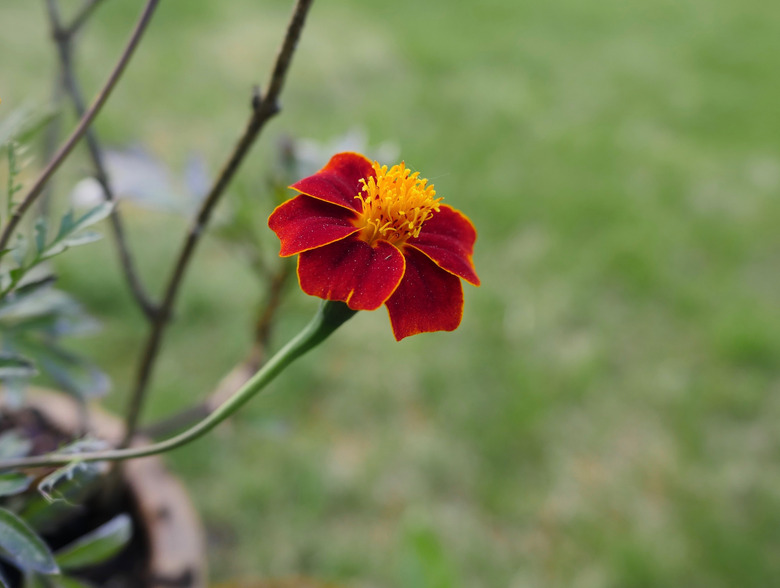Can I Plant Zinnias In Pots?
Flowering annuals grown in containers add color to an apartment terrace, a garden patio or any other outdoor spot. When choosing plants for potting, add some zinnias (Zinnia spp.) for blossoms that keep coming all season long. Zinnias grow as annuals in all parts of the United States and come in many different sizes, with flowers in varied shapes and vivid colors. Growing them is easy, requiring only a little care at the start and some tidying during the season.
Getting Started
Getting Started
Zinnias are easy to get started from seeds, because their seeds are large and easy to handle, and they usually germinate quickly. Start seeds indoors about six weeks before the last spring frost, sowing them in a moistened, soilless mixture in flats or small pots. Cover them with mix to a depth of about 1/4 inch and keep them lightly moist until seedlings sprout; keep in a sunny spot at room temperature until you're ready to transplant them into larger containers. This should usually happen after the weather starts to warm up and after having the seeds in a smaller pot for about five to six weeks.
You can also start by purchasing seedlings at a garden center or nursery, but don't buy them more than a day or two before you're ready to plant. This makes sure that they're in top shape when they go into the ground. Choose compact, well-branched plants with flower buds and healthy, bright green leaves that aren't discolored. If you can't plant immediately, water the seedlings and keep them in a shady spot until you're ready.
Plant seedlings in outdoor containers any time after danger of frost has passed.
Potting and Planting
Potting and Planting
Zinnias can grow in any type of container, including plastic or clay pots, wooden half-barrels, a window box or a hanging basket, but choose a container that has at least one drainage hole to help prevent fungal growth in the soil. Disinfect a previously used container to kill disease organisms or pests before use by soaking it in a solution that's one part bleach to nine parts water for 10 minutes, then clean it with water that contains a little dish detergent, and rinse well.
Zinnias come in many sizes, from varieties that grow 3 feet tall to dwarf cultivars only 6 inches high. You can plant any of these in a container. As they all spread to about 1 or 1 1/2 feet, a good rule of thumb for spacing is to set one zinnia in a 6-inch pot, three plants in a 10-inch pot and up to five zinnias in a 14-inch pot.
Soil, Sun, Water and Fertilizer
Soil, Sun, Water and Fertilizer
Plant zinnias in any commercial potting mix, or make your own. For example, for two 14-inch containers, combine 2 1/2 gallons peat moss, 2 1/2 gallons perlite, 1 1/4 gallons compost, 2 cups fine sand and 1/2 cup ground limestone. Don't use garden soil, which can harbor pests or disease-causing organisms.
Plant seedlings to the same level as they were in their original pot and water them well. Keep the zinnias in a sunny location that gets at least four hours of sun daily — more sun means more flowers — and water whenever the top inch or two of soil feels dry to the touch. Let the pot drain after watering and never keep it in a water-filled saucer.
To keep flowers coming all season, fertilize the pot weekly, using a water-soluble, 5-10-5 formula diluted at a rate of 1/4 teaspoon per gallon of water, but check your product label for specific mixing instructions and additional directions.
Trimming and Possible Problems
Trimming and Possible Problems
Zinnias continue producing new flower buds until plants dieback in the fall. But you can help keep the plants tidy by trimming off flowers as they fade away. This also helps promote new branching behind the old flower, keeping the plant bushy. Using sharp shears, cut off the stem just behind the old flower but in front of any new shoots that may be growing on the stem. Clean your blades with rubbing alcohol between cuts to prevent spread of plant disease.
Zinnias are usually free of any pest problems, but they are susceptible to several fungal problems, including powdery mildew which causes a white powder to accumulate on leaves that eventually wilt and dry up. This is best prevented by keeping the container in a spot with good air circulation and watering only at the plant's base, keeping foliage dry.
